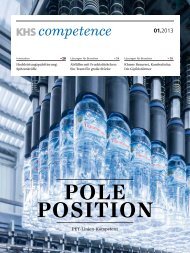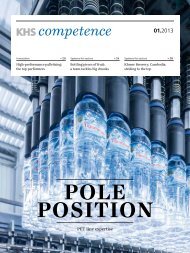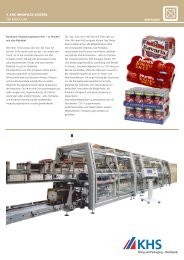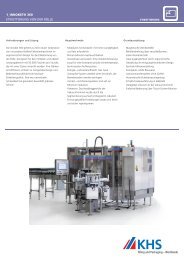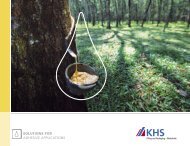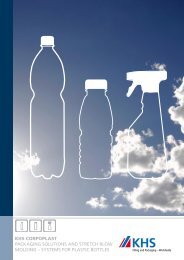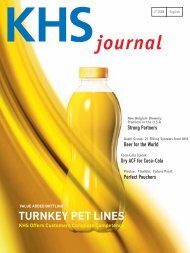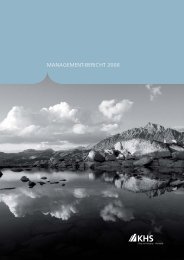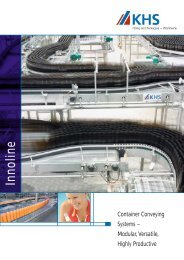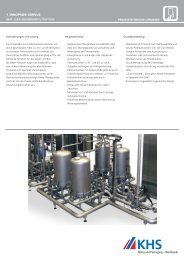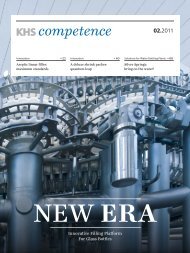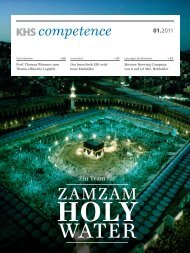KHS Competence drinktec | 2009
KHS Competence drinktec | 2009
KHS Competence drinktec | 2009
You also want an ePaper? Increase the reach of your titles
YUMPU automatically turns print PDFs into web optimized ePapers that Google loves.
<strong>KHS</strong> <strong>Competence</strong> <strong>drinktec</strong> | <strong>2009</strong><br />
Bottles & Shapes Provides Added Value<br />
Right Down The Line<br />
Practical example: development of a new Lipton iced tea, hotfill PET bottle for the Pepsi<br />
Bottling Group<br />
Bottles & Shapes is the name of the internationally unique service and consultancy<br />
program from <strong>KHS</strong> Corpoplast for the design and development of plastic bottles. <strong>KHS</strong><br />
Corpoplast falls back on over 35 years of experience in stretch blow molding and PET<br />
process technology and thus has a wealth of expertise in this field. Within the Bottles &<br />
Shapes program, <strong>KHS</strong> Corpoplast acts as a constant partner to companies in the food<br />
and non-food industries throughout the entire development of a plastic container – from<br />
the initial idea to its industrial manufacture. At all times there is extremely close<br />
collaboration with the Marketing and Engineering departments of the company to be<br />
advised. During each stage in the design of the container, the ecological, economical,<br />
and functional aspects of the packaging also undergo close scrutiny. The aim of the<br />
Bottles & Shapes program is always to create a container that fully meets marketing<br />
demands and is of the highest quality, while keeping costs to a minimum and ensuring<br />
sustainability throughout the entire production process. And of course, the plastic<br />
packaging always has to be premium. The optimum production of this premium plastic<br />
packaging is guaranteed not least by the use of InnoPET Blomax stretch blow molders<br />
from <strong>KHS</strong> Corpoplast, plant engineering that is not only setting standards in cost<br />
efficiency but also with regard to the precision of the plastic bottles produced with its<br />
outstanding process accuracy. In order to show just how much added value Bottles &<br />
Shapes can offer in a specific case, by way of example we shall now study the various<br />
stages in the program recently implemented at the Pepsi Bottling Group. The task here<br />
was to develop a new premium PET bottle for Lipton iced tea in 0.6, 1.0 and 1.5-liter<br />
sizes in accordance with a given, typical brand design while<br />
ensuring optimum functionality and minimized overall costs.<br />
Question one: which filling technology for which product?<br />
The first question always asked when the Bottles & Shapes program comes into play is:<br />
which products are to be filled in the resulting plastic bottle and which filling technology<br />
is to be used? The first stage also involves clarifying which other requirements will be<br />
made of the bottle to be manufactured such as the stress the plastic bottle is subjected to<br />
while being conveyed through the line and up to and including the palletizing process,<br />
1
<strong>KHS</strong> <strong>Competence</strong> <strong>drinktec</strong> | <strong>2009</strong><br />
and also during shipment to markets and points of sale.<br />
The task: to hot fill PET bottles without vacuum compensation panels<br />
In Pepsi's case, the task was to hot fill Lipton iced tea in a PET bottle with an exact visual<br />
appearance stipulated by the company. At first this seemed impossible; in order to<br />
ensure that they were suitable for hot filling, PET bottles to date have had to be equipped<br />
with vacuum compensation panels that made specific contours in the bottle shape<br />
necessary. The reason for this is that when hot product enters the PET bottle and cools, a<br />
vacuum is created. This vacuum usually causes the PET bottle to contract and shrink.<br />
Vacuum compensation panels prevent shrinking and maintain the shape stability of the<br />
PET bottle. However, these panels rather limit creativity when it comes to bottle design.<br />
The solution: nitrogen flushing of freshly filled PET bottles<br />
<strong>KHS</strong> Corpoplast then began looking for a way of enabling the specific PET bottles<br />
prescribed by Pepsi to be hot filled. The ingenious solution they came up with was<br />
HotFill+, an innovative method of hot filling in which no vacuum is created in the PET<br />
bottle thereby eliminating the need for vacuum compensation panels. Applying HotFill+<br />
meant that the Lipton iced tea bottle could now be developed in full accordance with<br />
Pepsi's requirements.<br />
The entire beverage industry will profit<br />
In developing this process, <strong>KHS</strong> Corpoplast once again made the virtually impossible<br />
possible – totally in the interests of the Pepsi Bottling Group. As with the results of any<br />
new research project, the entire beverage industry is set to profit to a large degree, with<br />
hotfill bottles now able to enjoy total freedom of design.<br />
The beverage sector will also benefit from another new development that is being applied<br />
to the Lipton iced tea bottle at Pepsi for the first time. Pepsi specifications were for<br />
premium PET bottle quality coupled with a reduction in overall costs – and the highest<br />
possible stretch blow molder output capacity.<br />
Since the chief way of noticeably cutting costs in manufacturing PET bottles is to reduce<br />
outlays for materials, <strong>KHS</strong> Corpoplast endeavored to considerably reduce the weight of<br />
the 0.6, 1.0 and 1.5-liter Lipton iced tea bottles. This reduction in expenditure for<br />
materials proved even more advantageous than originally thought; laboratory tests<br />
showed that it was not only possible to eliminate the need for vacuum compensation<br />
panels but also that the manufacturing process for the Lipton iced tea PET bottles could<br />
2
<strong>KHS</strong> <strong>Competence</strong> <strong>drinktec</strong> | <strong>2009</strong><br />
be optimized even further.<br />
Development of an optimized manufacturing process for savings in energy and<br />
compressed air<br />
The specific target of further process optimization was the blow process. Thermally<br />
induced crystallization in the PET material (to make the PET thermally resistant) and<br />
relaxing (to reduce tension) during the PET hotfill bottle blow molding process have been<br />
common practice to date. In order to thermally crystallize the PET, the blow molds<br />
usually have to be heated to temperatures of between 130 and 165°C. Filling tests on<br />
PET bottles produced for Lipton iced tea showed that at the temperature required for<br />
filling this particular product it is sufficient to rely on the relaxation effect of the PET<br />
during stretch blow molding and dispense with thermally induced crystallinity. This<br />
means that the blow molds only have to be heated to a temperature of 115°C during<br />
stretch blow molding, thus achieving considerable savings in energy. Another bonus in<br />
this context is that if only the relaxation process is used, there is no need to purge the<br />
insides of the bottles with cold air after stretch blow molding, as the shape of the PET<br />
bottles is stable thanks to the lower temperature used during blow molding. Simply by<br />
omitting this stage in the process, up to 60% compressed air is saved compared to the<br />
amounts needed in the manufacture of conventional hotfill PET bottles.<br />
Simplified blow molding and a higher bottle output<br />
Simplifying the stretch blow molding process for hotfill PET bottles destined for Lipton<br />
iced tea also helps to increase performance versus classic stretch blow molding. Where<br />
previously 1,200 to 1,400 hotfill PET bottles could be made an hour per blow station,<br />
using the new method of production this number increases to up to 1,800 per hour and<br />
blow station. Compared to the classic stretch blow molding process for hotfill PET bottles,<br />
this is an increase in production of up to 50%.<br />
Significant saving in material costs<br />
The simplified stretch blow molding process plus doing without vacuum compensation<br />
panels on the PET bottles results in a reduction in weight of between 7% and 25%,<br />
depending on the bottle size.<br />
The pilot project for the manufacture of newly developed PET bottles and the filling of<br />
Lipton iced tea therein was launched at the Pepsi Bottling Group in Russia where an<br />
InnoPET Blomax 24 CHR stretch blow molder with 24 blow stations makes the new hotfill<br />
bottles. Taking the manufacture of the 0.6-liter PET bottle for Lipton iced tea as an<br />
3
<strong>KHS</strong> <strong>Competence</strong> <strong>drinktec</strong> | <strong>2009</strong><br />
example, the stretch blow molder produces 43,200 0.6-liter PET bottles an hour –<br />
resulting in an annual saving in costs for PET of several thousand euros.<br />
The Bottles & Shapes program – always identical and yet completely individual<br />
The given data and newly developed manufacturing technologies are all the result of the<br />
Bottles & Shapes concept that is carefully planned right down to the last detail. In the<br />
Bottles & Shapes program, the process is always identical but carefully selected so that<br />
it allows maximum individuality. Once the question of packaging, product, and the<br />
expected forms of stress exerted on the container have been clarified, as mentioned in the<br />
above, <strong>KHS</strong> Corpoplast then suggests designs for all kinds of plastic bottle on request in<br />
close negotiation with the client company. These suggestions are geared towards market<br />
conditions and assessed for technical feasibility.<br />
Computer simulation of PET bottles using finite element analysis<br />
The shape of the container is developed using computer simulation. In finite element<br />
analysis, all known influences, such as stress and vacuum tension caused by excessive<br />
pressure, for example, are simulated and applied to the virtual packaging. The data on<br />
the system can be varied at any time which saves time and permits new settings to be<br />
made quickly. At Pepsi, computer simulation was a major component of the bottle<br />
design. Here, it was important to simulate and neutralize the vacuum tension for the<br />
given PET bottle sizes.<br />
Saving time and money with rapid prototyping<br />
If the features of the PET container generated by computer simulation meet customer<br />
requirements, <strong>KHS</strong> Corpoplast can produce prototypes of the new packaging within a<br />
very short space of time. Both plaster and plastic casts are available within just a few<br />
hours. Unlike virtual 3D design on screen, models give customers the chance to see their<br />
PET container for real before it goes into production. Its shape and form can be felt and<br />
its optical design is more detailed and better perceivable than when only seen on the<br />
computer screen. At the same time, through the fast production of a prototype no time<br />
is lost that could be detrimental to the launch to market.<br />
4
<strong>KHS</strong> <strong>Competence</strong> <strong>drinktec</strong> | <strong>2009</strong><br />
Laboratory testing – putting bottles through their paces<br />
The next stage in the Bottles & Shapes program is to make PET bottles on a laboratory<br />
machine. This lab setup works just like the stretch blow molders later used in practice.<br />
Efficiency, blow molding pressures, and the temperature profile used to heat the PET<br />
preforms and blow molds can all be demonstrated on the laboratory machine like on any<br />
<strong>KHS</strong> Corpoplast stretch blow molder. All process-relevant settings can thus be realized.<br />
The blow molds used on the lab machine are made by <strong>KHS</strong> Moldtec – as they are for the<br />
stretch blow molder that will later be in operation. This makes everything available from<br />
a one-stop shop – yet another major advantage for the customer. What's more, <strong>KHS</strong><br />
Moldtec has a mine of experience that is practically untoppable! Over 4,000 different<br />
blow molds are made here each year. Besides stretch blow molding, the <strong>KHS</strong> Corpoplast<br />
laboratory also simulates the ensuing filling process in full accordance with practical<br />
specifications.<br />
In the case of the Lipton iced tea bottle, the lab tests were primarily to determine whether<br />
the relaxation process alone could meet the given hotfill conditions in the manufacture of<br />
PET bottles. Researchers also examined whether the bottle design had to be modified in<br />
order to neutralize the presence of vacuum.<br />
Sample containers for the first practice run<br />
Only when test results confirm all given specifications does the certified <strong>KHS</strong> Corpoplast<br />
laboratory approve the plastic container for production. This is usually followed by tests<br />
in practice. <strong>KHS</strong> Corpoplast provides the necessary plastic sample packaging for market<br />
testing, filling tests, and labeling, packaging, and palletizing tests. Pepsi also ordered<br />
sample bottles that were rigorously put through their paces. The result was that<br />
production went just as <strong>KHS</strong> Corpoplast had forecast.<br />
In all test results, <strong>KHS</strong> Corpoplast emphasizes that numerous features, such as ultra<br />
lightweighting, require the highest accuracy of process repeatability. InnoPET Blomax<br />
stretch blow molders from <strong>KHS</strong> Corpoplast not only have an excellent record of efficiency<br />
and availability; they are also leaders when it comes to process precision, underlined by<br />
the precision mandrel guidance of the preforms, a minimum pitch and thus best heat<br />
penetration of the preforms; they have the best values when it comes to repetition of the<br />
stretch blow molding process and distribution of materials and extremely fast switching<br />
blow valves with lowest possible dead air volume.<br />
5
<strong>KHS</strong> <strong>Competence</strong> <strong>drinktec</strong> | <strong>2009</strong><br />
The result is top quality<br />
The Bottles & Shapes program offers the companies it services a well-founded, efficient<br />
source of expert knowledge. It covers everything, from the first ideas for the design and<br />
marketing of the prospective container to CAD bottle design and development; from<br />
preform and blow mold specifications to the industrial manufacture of the PET bottles.<br />
The program creates plenty of impressive added value for beverage companies that pays<br />
off in a number of different respects. Yet when it comes down to it, all arguments in<br />
favor of the Bottles & Shapes program have one central message: Bottles & Shapes is<br />
about optimum quality – and about premium plastic bottles.<br />
6



